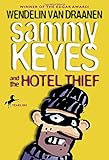Textual Analysis Lesson: Forensic Science Files: Handwriting Analysis
Lesson Plan
Sammy Keyes and the Hotel Thief | 840L

- Learning Goal
- Use the Textual Analysis process to answer comprehension questions about a text.
- Duration
- Approximately 1 Day (20-25 minutes)
- Necessary Materials
- Provided: “Forensic Science Files: Handwriting Analysis” Reading Passage – (Student Packet, pp. 21-22), “Forensic Science Files: Handwriting Analysis” Textual Analysis Questions (Student Packet, p. 23)
Before the Lesson:
Read Sammy Keyes and the Hotel Thief, Chapters 1-13; Complete Student Packet Worksheets for Chapters 1-1
Activation and Motivation
I will recall that Sammy Keyes has come across a handwritten note that could possibly be evidence in the crime of the hotel thief. I will explain that some investigators specialize in handwriting analysis to learn more about a crime or a suspect when there is handwritten evidence involved in a case.
Have students take turns copying this sentence in their own handwriting on the board, “My handwriting gives clues to my personality.” When each student has had a chance to write the sentence on the board, ask them to talk about the various types of handwriting they see. Engage the class in a discussion about the similarities and differences between the different writing styles. Ask, "Which style is neater? Which looks like it’s scribbled quickly"? Ask students if they agree with the sentence they copied. Why or why not? Discuss the writing styles with students. Can they conclude anything about the person who wrote the sentence by looking at that person’s handwriting? What can they conclude?
Tell students that they will read the “Forensic Science Files: Handwriting Analysis” Reading Passage to learn background information about how handwriting is analyzed. Instruct students to carefully follow the steps for Textual Analysis to read the passage and answer the questions that follow. Be sure to have students discuss and prove their answers after they are done.
Before Reading
- Read the passage title, introduction, and any captions.
- Look at any pictures or photographs.
- Read the first two sentences only.
- Stop! Brainstorm what you think the text is going to be mostly about.
- Read and label the Textual Analysis questions with the Concepts of Comprehension.
- Do not read the answer choices. Spend only a few seconds labeling each question with the appropriate Concepts of Comprehension.
During Reading
- Read the whole section of text that was assigned.
- As you read, underline or highlight any information that may help you answer the question. If you are doing TA with a book, use sticky notes to flag information.
- Have students answer questions independently.
- Use the process of elimination for any questions for which you are not positive of the answer.
After Reading
- Prove all of your answers by underlining or copying evidence from the text. Go back and check your work. Do your answers make sense? Can you prove each answer?
- Share your answers with the group. Use text evidence to explain why you think an answer is correct.
-
Guidance for Questions 4 and 7:
- For Question 4, discuss answer choices “A” and “B” as two possible definitions of simulation. Answer choice “A,” forgeries or fakes, defines simulation as an imitation. Answer choice “B,” “demonstrations,” might define simulations as models or representations. Discuss which option best fits the context of this text.
- For Question 7, engage students in discussion about why the specific elements that they identified are important to handwriting analysts. Extend the discussion by drawing conclusions about what each element might say about the manner in which the sample was written or about the suspect themselves.
TIP:
Build Student Vocabulary analyze
Texts & Materials
Standards Alignment
(To see all of the ReadWorks lessons aligned to your standards, click here.)
